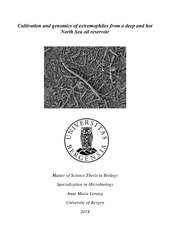| dc.description.abstract | In this study, production water from the Troll B oilfield in the North Sea has been used as a source in order to isolate and characterize new extremophilic prokaryotes. Anaerobic enrichment cultures with different carbon sources and growth conditions were made in order to enrich specifically for novel groups and species of thermophilic anaerobes. Growth was obtained in enrichments incubated at 55°C with casamino acids, glucose, peptone, yeast extract, arabinose, maltose, dextrin, threonine and serine as substrates. Isolation of organisms was performed by dilution to extinction prior to identification through 16S rRNA gene sequence analyses. A total of seven strains, belonging to the Thermotogae and Synergistetes phyla, were obtained. All the isolates but one belonged to species (Thermovirga lienii, Petrotoga mobilis, and Thermosipoho africanus) previously isolated from North Sea oil wells with 16S rRNA gene sequence identities above 99%. One isolate, recovered using glucose and yeast extract as substrates in presence of 5% NaCl shared 99.3% sequence identity with the Thermotogales organisms, Petrotoga mexicana, which has previously only been recovered from a oil field in the Gulf of Mexico. A draft genome sequencing of this isolate, termed Petrotoga mexicana strain Troll was done using paired-end Illumina HiSeq sequencing performed by a commercial genome sequence provider. Ninety sequence contigs constituting a total of 2,116,100 bases were obtained. The sequencing indicates a genome length less than 2.2 Mb. The genome was annotated and analysed using Rapid Annotation Subsystem Technology (RAST), and compared to the Petrotoga mobilis genome, the closest genome-sequenced relative. Based on the genomic sequence, metabolic features of strain Troll were analysed and compared to Petrotoga mobilis. Although the main energy metabolism seems to be based on glycolysis with lactate as main fermentation product, some unexpected features, e.g. the presence of genes for a respiratory complex I, a Na^+-translocating NADH-quinone oxidoreductase and carbon monoxide dehydrogenase were identified. A large number of transport systems for amino acids, peptides, sugars and minerals were also identified as well as a complete xylan degradation pathway. A difference of 2.2% in G+C content from the Petrotoga mexicana type strain as well as morphological differences indicates that strain Troll may represent a novel Petrotoga species. | en_US |
